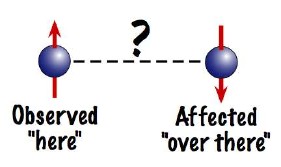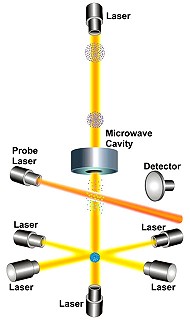|
Researchers are hoping to improve
high-precision clocks by entangling their atoms.
by Patrick L Barry and Dr Tony
Phillips
Einstein called it
"spooky action at a distance." Now researchers are using an astonishing
property of quantum mechanics called "entanglement" to improve atomic
clocks - humanity's most precise way to measure time. Entangled
clocks could be as much as 1000 times more stable than their non-entangled
counterparts.
This improvement would
benefit pilots, farmers, hikers - in short, anyone who uses the Global
Positioning System (GPS). Each of the 24+ GPS satellites carries
four atomic clocks on board. By triangulating time signals broadcast
from orbit, GPS receivers on the ground can pinpoint their own location
on Earth.
NASA uses atomic clocks
for spacecraft navigation. Geologists use them to monitor continental
drift and the slowly changing spin of our planet. Physicists use
them to check theories of gravity. An entangled atomic clock might
keep time precisely enough to test the value of the Fine Structure
Constant, one of the fundamental constants of physics.
"The ability to measure
time with very high precision is an invaluable tool for scientific
research and for technology," says Alex Kuzmich, a physicist at
the Georgia Institute of Technology.
Through its office
of Biological and Physical Research, NASA recently awarded a grant
to Kuzmich and his colleagues to support their research. Kuzmich
has studied quantum entanglement for the last 10 years and has recently
turned to exploring how it can be applied to atomic clocks.
Einstein never liked
entanglement. It seemed to run counter to a central tenet of his
theory of relativity: nothing, not even information, can travel
faster than the speed of light. In quantum mechanics, all the forces
of nature are mediated by the exchange of particles such as photons,
and these particles must obey this cosmic speed limit. So an action
"here" can cause no effect "over there" any sooner than it would
take light to travel there in a vacuum.

Image by Patrick L. Barry
Making
a measurement on one entangled particle affects the properties
of the other instantaneously.
|
But two entangled particles
can appear to influence one another instantaneously, whether they're
in the same room or at opposite ends of the Universe. Pretty spooky
indeed.
Quantum entanglement
occurs when two or more particles interact in a way that causes
their fates to become linked: It becomes impossible to consider
(or mathematically describe) each particle's condition independently
of the others'. Collectively they constitute a single quantum state.
Two entangled particles
often must have opposite values for a property - for example, if
one is spinning in "up" direction, the other must be spinning in
the "down" direction. Suppose you measure one of the entangled particles
and, by doing so, you nudge it "up." This causes the entangled partner
to spin "down." Making the measurement "here" affected the other
particle "over there" instantaneously, even if the other particle
was a million miles away.
While physicists and philosophers grapple with the implications
for the nature of causation and the structure of the Universe, some
physicists are busy putting entanglement to work in applications
such as "teleporting" atoms and producing uncrackable encryption.
Atomic clocks also
stand to benefit. "Entangling the atoms in an atomic clock reduces
the inherent uncertainties in the system," Kuzmich explains.
At the heart of every
atomic clock lies a cloud of atoms, usually cesium or rubidium.
The natural resonance's of these atoms serve the same purpose as
the pendulum in a grandfather clock. Tick-tock-tick-tock. A laser
beam piercing the cloud can count the oscillations and use them
to keep time. This is how an atomic clock works.
"The best atomic clocks
on Earth today are stable to about one part in 1015,"
notes Kuzmich. That means an observer would have to watch the clock
for 1015 seconds or 30 million years to see it gain or
lose a single second.

Click on the image to learn more.
Lasers are a key ingredient of atomic clocks - both the ordinary and
entangled variety.
|
The precision of an
atomic clock depends on a few things, including the number of atoms
being used. The more atoms, the better. In a normal atomic clock,
the precision is proportional to the square-root of the number of
atoms. So having, say, 4 times as many atoms would only double the
precision. In an entangled atomic clock, however, the improvement
is directly proportional to the number of atoms. Four times more
atoms makes a 4-times better clock.
Using plenty of atoms,
it might be possible to build a "maximally entangled clock stable
to about one part in 1018," says Kuzmich. You would have
to watch that clock for 1018 seconds or 30 billion years
to catch it losing a single second.
Kuzmich plans to use
the lasers already built-in to atomic clocks to create the entanglement.
"We will measure the
phase of the laser light passing through the cloud of atoms," he
explains. Measuring the phase "tweaks the laser beam," and if the
frequency of the laser has been chosen properly, tweaking the beam
causes the atoms to become entangled. Or, as one quantum physicist
might say to another, "such a procedure amounts to a quantum non-demolition
(QND) measurement on the atoms, and results in preparation of a
Squeezed Spin State."
How soon an entangled
clock could be built - much less launched into space aboard a hypothetical
new generation of GPS satellites - is difficult to predict, cautions
Kuzmich. The research is still at the stage of just demonstrating
the principle. Building a working prototype is probably several
years away.
But thanks to research such as this, having still-better atomic
clocks available to benefit science and technology is only a matter
of time.
|
